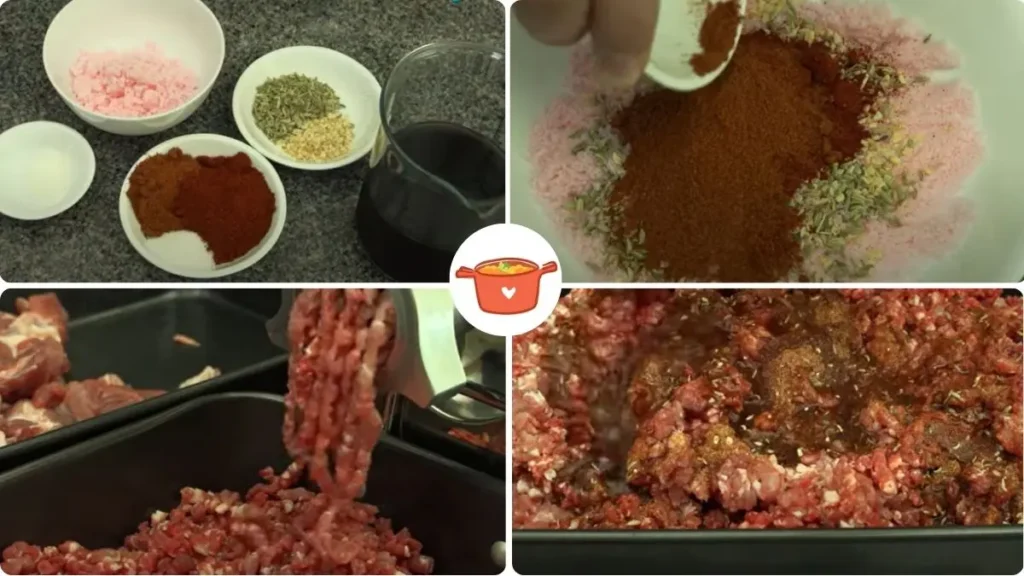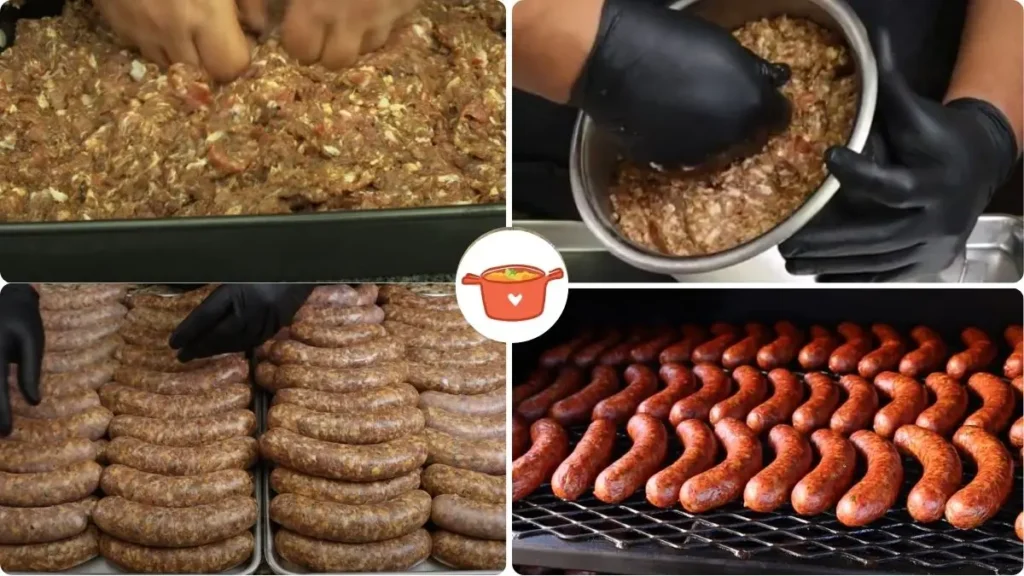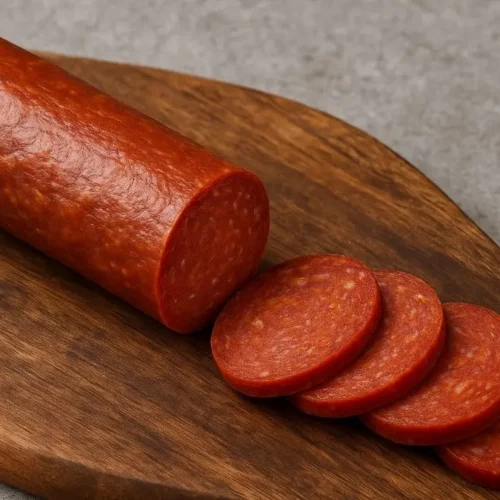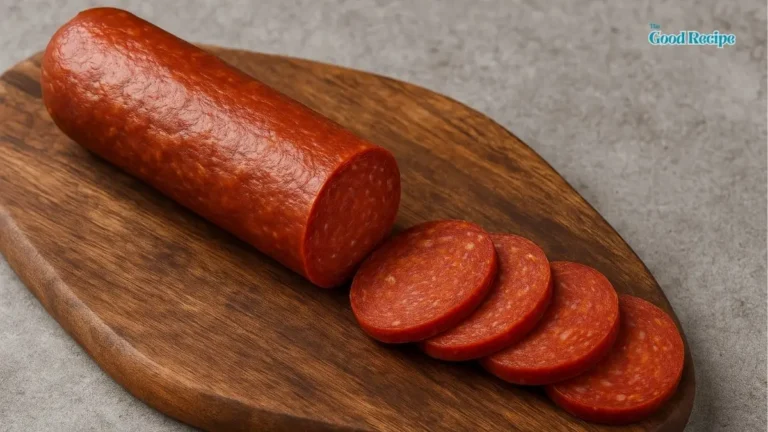Creating your own pepperoni sausage at home is one of the most rewarding culinary adventures you can embark upon. This traditional cured and fermented sausage brings together the perfect balance of spices, meat, and time to create something truly exceptional.
Making pepperoni from scratch might seem intimidating, but with the right technique and patience, you’ll discover it’s an achievable goal for any dedicated home cook. The process involves careful preparation, proper curing, and controlled fermentation that transforms simple ingredients into complex, flavorful sausage.
This homemade pepperoni sausage recipe will guide you through every step of creating authentic, restaurant-quality pepperoni that’s absolutely loaded with flavor and aroma. Get ready to impress your family and friends with this incredible homemade delicacy.
What Does Pepperoni Sausage Recipe Taste Like?
Homemade pepperoni sausage delivers an incredibly complex flavor profile that store-bought versions simply cannot match. The initial taste hits you with a perfect balance of savory pork and beef, enhanced by the deep, smoky notes from paprika and the subtle heat from cayenne pepper.

As you continue to savor each bite, the fermentation process reveals itself through tangy, slightly acidic undertones that complement the rich meat beautifully. The garlic granules and anise seed add layers of aromatic complexity, while the curing process concentrates all these flavors into an intensely satisfying experience.
The texture is firm yet tender, with just the right amount of chew that makes each slice incredibly satisfying. The natural casing provides a pleasant snap when you bite into it, releasing all those concentrated flavors and aromas that make pepperoni an all-time favorite sausage.
Ingredients Required for Pepperoni Sausage Recipe
Here’s the list of Ingredients you’ll need to make this Pepperoni Sausage
- 3 lbs pork butt (shoulder), cut into cubes
- 2 lbs chuck steak, cut into cubes
- 2 tsp Prague powder
- 2 tbsp sugar
- 1 tsp cayenne pepper
- 2 tbsp paprika
- 1 tsp anise seed
- 2 tsp garlic granules
- ¼ cup red wine
- 1 tsp ascorbic acid
- Mini salami casings (40mm)
Kitchen Utensil You’ll Need
- Meat grinder with 8mm (⅓ inch) grinding plate
- Sausage stuffer with 40mm nozzle
- Large roasting tin
- Digital scale
- Sharp knife
- Fork for mixing spices
- Cling wrap
- Kitchen twine or string
Prep Time: 2 hours (plus 24 hours curing)
Active Cooking Time: 30 minutes
Curing/Fermentation Time: 6-12 weeks
Total Time: 6-12 weeks
Serves: Makes approximately 8-10 mini pepperoni sausages
How to Make Pepperoni Sausage
Simply follow the steps given below to make your Pepperoni Sausage Recipe at home
1. Prepare the Spice Blend: Combine Prague powder, sugar, cayenne pepper, paprika, anise seed, garlic granules, and ascorbic acid in a bowl. Use a fork to break down any lumps and ensure even distribution.

2. Prepare the Meat: Cut pork butt and chuck steak into uniform cubes, leaving all fat intact. Place meat in a large roasting tin and freeze for 60 minutes until firm but not completely frozen.
3. Grind the Meat: Using an 8mm grinding plate, run the pork and beef through your meat grinder separately. Keep the ground meat cold throughout the process.
4. Season and Mix: Pour the spice blend and red wine over the ground meat. Massage thoroughly while mixing the pork and beef together until well combined.
5. Initial Cure: Tamp the seasoned meat down firmly, cover with cling wrap, and refrigerate for 24 hours to allow curing to begin.
6. Stuff the Casings: Load meat into sausage stuffer with 40mm nozzle. Slide mini salami casing onto funnel. Apply firm pressure while cranking to create tightly packed sausages with no air pockets.
7. Seal the Ends: Remove casing from funnel, twist off the end, and secure with slip knots and double knots. Trim excess casing.

8. Ferment and Dry: Hang pepperoni by their loops in an environment maintained at 10-13°C (50-55°F) with 80% humidity for 6-12 weeks, depending on desired dryness and fermentation level.
Some Tasty Ways To Customize and Serve This Pepperoni Sausage
After making countless batches of this homemade pepperoni over the years, we’ve discovered some absolutely incredible ways to showcase all that hard work and amazing flavor.
1. Classic Pizza Perfection
Nothing beats thin slices on a homemade pizza. The oils from our pepperoni create those beautiful little cups that hold all the delicious rendered fat – it’s pure magic on every bite.
2. Elevated Charcuterie Boards
We love arranging thick slices alongside aged cheeses, olives, and crusty bread. The complex fermented flavors really shine when paired with a nice Chianti or bold red wine.
3. Gourmet Pasta Addition
Diced pepperoni transforms simple pasta dishes into restaurant-quality meals. We particularly love it in carbonara or tossed with fresh arugula and cherry tomatoes.
4. Breakfast Game Changer
Thin slices in scrambled eggs or frittatas add incredible depth. We’ve been doing this for weekend brunches and guests always ask for the recipe.
5. Sandwich Superstar
Layer it in Italian subs with provolone and roasted red peppers. The homemade quality makes such a difference compared to store-bought versions.
6. Antipasto Salad Hero
Julienned pepperoni brings authentic Italian flavors to Jennifer Garner Salad with mozzarella, olives, and balsamic vinaigrette. It’s become our go-to summer dinner.
7. Stuffed Bread Filling
We dice it for stuffed focaccia or calzones. The concentrated flavors hold up beautifully during baking and infuse the entire bread.
8. Soup Enhancement
A few slices floating in minestrone or Italian wedding soup add richness without overwhelming the other ingredients. Pure comfort food perfection.
9. Flatbread Elegance
Paired with caramelized onions and goat cheese on naan or flatbread creates an sophisticated appetizer that disappears within minutes at parties.
10. Mac and Cheese Upgrade
This might sound unconventional, but diced pepperoni in baked mac and cheese creates an incredible fusion that adults and kids absolutely love.
Some Tips on This Pepperoni Sausage Recipe
Making pepperoni at home can seem scary, but we have some great tips to help you win! Here are the best tricks we learned over the years:
1. Keep Everything Cold
Your meat grinder and all the meat parts need to stay very cold. Put your grinder parts in the freezer for 30 minutes before you start. Cold meat grinds better and stays fresh.
2. Don’t Skip the Prague Powder
This pink salt keeps your pepperoni safe to eat. Never leave it out! You can buy it online or at stores that sell meat making stuff.
3. Mix Really Well
Spend lots of time mixing the meat and spices. Your hands will get tired, but good mixing makes the best taste. Mix for at least 5 minutes.
4. Pack It Tight
When you stuff the casings, pack the meat in really tight. No air bubbles! Air bubbles can make bad germs grow and ruin your pepperoni.
5. Check Your Temp and Wetness
You need a place that stays 50-55 degrees and feels really humid. A basement works great. Buy a cheap meter to check both things.
6. Be Patient
Good pepperoni takes time. Don’t rush it! The longer it hangs, the better it tastes. Start checking after 6 weeks, but 8-10 weeks is even better.
7. Clean Everything
Wash all your tools really well before you start. Clean hands, clean grinder, clean everything. This keeps bad germs away from your food.
8. Start Small
Don’t make a huge batch first time. Make just a few pepperonis to learn how. You can always make more later when you get good at it
9. Write It Down
Keep notes about what you did and how it turned out. Next time you can make it even better! Write down dates and what it looked like each week.
10. Ask for Help
Find online groups where people make sausages. They love to help new people! Don’t be shy about asking questions when you get stuck.
How to Store and Reheat Pepperoni Sausage
Properly cured pepperoni can be stored in the refrigerator for up to 3 months when wrapped in butcher paper or cheese cloth. For longer storage, vacuum seal and freeze for up to 6 months. Once sliced, consume within 7-10 days and store in airtight containers in the refrigerator.

Pepperoni Sausage Recipe
Ingredients
- 3 lbs pork butt shoulder, cut into cubes
- 2 lbs chuck steak cut into cubes
- 2 tsp Prague powder
- 2 tbsp sugar
- 1 tsp cayenne pepper
- 2 tbsp paprika
- 1 tsp anise seed
- 2 tsp garlic granules
- ¼ cup red wine
- 1 tsp ascorbic acid
- Mini salami casings 40mm
Instructions
- Prepare the Spice Blend: Combine Prague powder, sugar, cayenne pepper, paprika, anise seed, garlic granules, and ascorbic acid in a bowl. Use a fork to break down any lumps and ensure even distribution.
- Prepare the Meat: Cut pork butt and chuck steak into uniform cubes, leaving all fat intact. Place meat in a large roasting tin and freeze for 60 minutes until firm but not completely frozen.
- Grind the Meat: Using an 8mm grinding plate, run the pork and beef through your meat grinder separately. Keep the ground meat cold throughout the process.
- Season and Mix: Pour the spice blend and red wine over the ground meat. Massage thoroughly while mixing the pork and beef together until well combined.
- Initial Cure: Tamp the seasoned meat down firmly, cover with cling wrap, and refrigerate for 24 hours to allow curing to begin.
- Stuff the Casings: Load meat into sausage stuffer with 40mm nozzle. Slide mini salami casing onto funnel. Apply firm pressure while cranking to create tightly packed sausages with no air pockets.
- Seal the Ends: Remove casing from funnel, twist off the end, and secure with slip knots and double knots. Trim excess casing.
- Ferment and Dry: Hang pepperoni by their loops in an environment maintained at 10-13°C (50-55°F) with 80% humidity for 6-12 weeks, depending on desired dryness and fermentation level.
Video
Notes
Common Queries on This Pepperoni Sausage Recipe
Here, we’ve got you covered with some common questions about the Pepperoni Sausage Recipe that people often ask.
After years of making this pepperoni recipe and helping countless home cooks through the process, we’ve compiled the most common questions we get. Here are our answers based on real experience:
1. Can I make pepperoni without Prague powder?
We strongly advise against it. Prague powder #1 is essential for food safety in cured meats – it prevents botulism and gives pepperoni its characteristic color and flavor. We’ve never found a safe substitute that works as effectively.
2. What happens if I don’t have the exact temperature and humidity for curing?
We’ve learned this the hard way – proper conditions are crucial. Too warm or too humid leads to spoilage, while too cold or dry stops fermentation. We invested in a wine fridge and humidifier after losing our first few batches to poor conditions.
3. How do I know when my pepperoni is ready?
After making dozens of batches, we look for these signs: the casing feels firm but not rock-hard, it’s lost about 30-40% of its original weight, and when sliced, there’s no soft or wet interior. The aroma should be pleasantly tangy and spicy.
4. Can I use different meat ratios?
A: We’ve experimented extensively with this. The 3:2 pork to beef ratio gives optimal flavor and texture. Too much beef makes it dry, while too much pork can make it greasy. Stick with our tested ratio for best results.
5. My pepperoni developed white mold – is it safe?
White, powdery mold is actually good! We’ve learned that beneficial Penicillium nalgiovense creates this protective coating. However, any green, black, or fuzzy mold means you should discard the batch immediately.
6. Can I speed up the curing process?
Unfortunately, no. We’ve tried various shortcuts over the years, and they all resulted in inferior flavor or unsafe products. The 6-12 week timeline allows proper fermentation and moisture loss – there’s no safe way to rush it.
7. What size casings should I use if I can’t find 40mm?
We’ve used 38-42mm casings successfully. Smaller casings cure faster but may case burst from overstuffing, while larger ones take longer to cure. The 40mm size we recommend gives the perfect balance of curing time and final texture.
8. How tightly should I stuff the casings?
This took us several attempts to master. Pack them very firmly – much tighter than regular sausages. Any air pockets can cause spoilage during the long curing process. The casing should feel almost rock-solid when properly stuffed.
9. Can I make pepperoni in a regular refrigerator?
We tried this early on and it doesn’t work well. Regular fridges are too cold and too dry. You need consistent 50-55°F temperatures and 80% humidity. We recommend investing in a curing chamber or wine fridge with humidity control.
10. How long will my finished pepperoni last?
Properly made and stored pepperoni lasts 3-4 months in the refrigerator. We wrap ours in butcher paper, which allows it to breathe while preventing it from drying out too much. Once sliced, consume within a week for best quality.
Crafting your own pepperoni sausage recipe at home is truly a labor of love that pays incredible dividends in flavor and satisfaction. This traditional method produces pepperoni that surpasses anything you can buy in stores, with complex flavors that develop through proper curing and fermentation. Ready to start your pepperoni-making journey? Gather your ingredients and equipment, then follow this time-tested recipe for amazing results that will make you the hero of every pizza night and charcuterie board!
Feel free to share your experience with this recipe by trying it out. Don’t forget to drop a comment and provide your feedback on the blog for us to read.
Additionally, You can also like and, follow us on Pinterest, and Reddit for more updates. Your thoughts and engagement are greatly appreciated!


Thanks for the recipe
Welcome